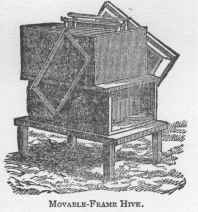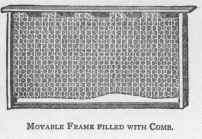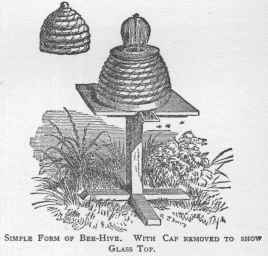BEE-KEEPING AND MANAGEMENT.
Bees, Feeding........................ 72
Bees, Italian......................... 73
Brood, Foul.......................... 73
Care of Bees in Winter............... 72
Enemies of Bees..................... 73
English Straw-Hive.................. 71
Feeding Bees........................ 72
Foul Brood.......................... 73
Frames, Movable.................... 71
Getting the Honey................... 72
Hives................................. 71
Hiving Swarms ..................... 72
Honey, Getting the................... 72
Italian Bees.......................... 73
Movable Frames...................... 71
Pasturages, Succession of............ 70
Plants adapted to Pasturage......... 70
Profitable Number of Swarms........ 71
Profits............................... 73
Robber Bees.......................... 73
Straw-Hives, English................ 71
Succession of Pasturages............. 70
Swarming........................... 72
Swarms, Profitable Number of....... 71
Their Enemies...................... 73
Water................................ 73
Winter, Care of Bees in.............. 72
PLANTS ADAPTED TO BEE
PASTURAGE.
The prevalence of honey-bearing plants must
be carefully considered in deciding what number
of hives may be profitably kept. Garden flow
ers are not, as is often supposed, a prolific
source from which bees get honey. Of the
clovers, the sweet, or red, and the Alsike are emi
nent for their honey-bearing qualities, while the
white clover is valuable only as bee-pasturage.
The white and Alsike bloom in June and July,
but the red clover is useless as bee-food until
the second growth blossoms, after hay has been
made of the first crop. The bee-keeper must
be governed by the prevalence of bloom in his
particular neighborhood, in estimating the num
ber of swarms which may find forage during
April and May—a very trying time for bees.
Corn is the great honey-producing plant all over
the West, until August, and until frost appears,
when buckwheat takes its place, and during the
later season the wild flowers are available.
Sumac and white sage are valuable in California,
while the cotton-plant is a prolific source in the
South. In various parts of the country, mus
tard, rape and milk weeds yield honey abund
antly.
SUCCESSION OF PASTURAGES.
The first trees to produce bloom in the spring
are the red and white maples, the aspens and
willows. South of 40 degrees, the red bud
(Judas-tree) is prolific in its bloom, May gives
us alder, sugar - maple, haws, crab-apple and
nearly all fruit-trees and bushes. In May and
early June we have the barberry, grape, white-
wood, (tulip-tree), sumac, and during June the
BEE-KEEPING AND MANAGEMENT. 71
wild plum, raspberry and blackberry; July
gives us basswood, Virginia creeper and button-
bush. In the hilly regions of the South all these
trees thrive; many of them are not found in the
West. In California the pepper-tree and red
gum are noted for late bloom. When there are
plenty of these plants the bee-keeper need fear
no lack of bloom, even leaving out of account
others not mentioned here.
HIVES.
The hive should be closely jointed and strong
ly fastened together. In its construction study
simplicity first. About 4000 cubic inches should
be its contents, if comb-honey in frames is de
sired ; 2000 cubic inches or even less will an

swer if the surplus honey is to be contained in
caps. We give a cut showing a hive that any
one who can use carpenter‘s tools can make,
or the several parts can be bought, ready to
put together, of any firm dealing in bee-keeper's
supplies. It is called the Langstroth hive. Its
working-parts are easily adjusted ; it comes as
near as possible to being moth and vermin-
proof: no hive can be entirely so.
MOVABLE FRAMES.
We give, herewith, two illustrations, showing
different styles of movable frames, the smaller

one having but a few cells of comb in it, the lar
ger one completely filled. Six or eight inches
square is the size of the smaller, which when
filled with comb will hold about a pound of
honey. Placed side by side and joined together,
a number of them will occupy the same space
in a hive as a larger frame. Of
course the more convenient for
handling are the small frames;
by their use honey can be sold in
small quantities, frame and all, to
suit retail buyers.

ENGLISH STRAW-HIVES.
In Great Britain, where the bee-keeper does
not wish to closely examine the habits of his
bees, the old-fashioned straw-hive, so long com
mon as the emblem of industry, still holds its

own. In some parts of Europe, cork hives are
used, and in Turkey and Greece they are made
of earthenware. Our English friends think that
a good straw-hive is a better protection to the
bees and the honey than one of wood. We
give a cut of a hive popular with them.
PROFITABLE NUMBER OF SWARMS.
Don‘t get too many swarms. When a few
swarms are kept, the bees are healthy and give
plenty of surplus honey because there is plenty
of foliage for them to make it from. When the
swarms are increased too largely, the result is, of
course, light crops of honey, diseases, and all
imaginable pests, and finally starvation. Great
care and breeding artificially may, to be sure,
prevent this where the farmer has the time to
devote to it, but he seldom has this time.
Twenty is the largest number we have been able
to keep, and keep profitably and healthily, even
on the most prolific of feeding grounds. In
deed the greatest profit with the least outlay
has been from ten to twelve swarms, and some
locations will not support more than half this
number. Five or six swarms may be kept on
almost any farm-range,
72 THE FRIEND OF ALL.
SWARMING.
It is well for every farmer to have his bees
swarm as early in the season as possible. The
old “ saw” says:
“ A swarm in May is worth a load of hay;
A swarm in June is worth a silver spoon;
A swarm in July is not worth a fly.”
Always bear this in mind. Early swarms be
come populous, and have plenty of honey before
the dry season and heat cut off the supply of
food, and are able to carry themselves through.
Late swarms are weak, and finally succumb to
the inevitable.
HIVING SWARMS.
When you are working around bees avoid all
hasty or quick movements. These provoke
stinging. If by any means a bee gets crushed or
pinched in your clothing, it will sting you ; other
wise there is little danger unless you go about
the work in an excited manner. In case you are
stung, get out of the way quietly and as quickly
as possible, before the odor of the sting excites
the whole swarm. An ounce of prevention is
better than a pound of cure. Protect yourself
as much as possible by putting on the hands
leather gauntlet-gloves and tying them firmly
about the wrists, tying the pantaloons tightly
around the legs of the boots, and wearing thick
loose clothes. A bee-veil is an ordinary piece of
netting tied or sewed about the rim of the hat
and tucked inside the coat-collar, etc. If the bees
are settled upon a handy bush, simply shake them
carefully into the hive, as many as you can, hav
ing of course got your hive all ready beforehand.
Cover the hive, and place it near where the
other bees may enter. If the larger part of the
swarm falls to the ground, drive them to the
entrance by gently and carefully sweeping them
with something soft. When they begin to enter,
leave them to themselves until evening, when
they must be set where they are to remain per
manently. In case of the swarm settling on a
limb so far up that you cannot reach it, tie one
end of a rope around the limb, and throw the
other end up over a higher limb, passing it to an
assistant on the ground. Then saw off the limb,
easing on the rope so that the limb will fall
gently to the ground, that it may not disturb
the bees. Put the bees into the hive as already
directed. You will seldom lose a swarm if you
keep your eyes open and hold yourself in readi
ness when indications of a swarm are apparent.
The beating of tin pans and throwing of water
and sand among the swarms is useless. But in
case of their rising up and seeming inclined to
make off, a good dash of water or sand will often
bring them to the ground, doubtless because they
think it a bad day for swarming. Swarm-catchers
are sometimes used: a bushel-basket on a long
handle makes a good one.
GETTING THE HONEY.
Wait until you are sure the bees are filled with
honey before you try to work about them. Be
ing alarmed in any way, as tapping on the hive
or smoking, they will at once fill themselves with
honey. Let them get filled—it will not take
above five minutes—and they will be quiet, and
will not sting unless hurt. Now remove the
HONEY-KNIFE.

BELLOWS AND SMOKING-TUBE.
honey, paying no attention to the flying bees. If
you do, they will sting you. We give a good
cut of a popular form of smoker. Very little
smoke answers the purpose : a few whiffs from
an ordinary tobacco-pipe will answer. If the
honey sticks, cut it with a thin knife as shown
in the cut.
CARE OF BEES IN WINTER.
A shelter facing southeast, and having water-
tight roof and three sides, is the best place for
bees all the year round, the open front being pro
tected by shutters or otherwise to keep out the
snow in winter. The hives should stand about
a foot above ground, and sometimes in severe
weather be protected with straw or corn-stalks.
Bees, as before stated, endure extreme cold when
healthy, and with plenty of food. Wet and snow
among them are fatal.
FEEDING BEES.
A multitude of appliances have been invented
for this purpose. But the old simple way is as
good as any. Take a common wide-mouth
pickle-bottle; fill it with syrup, and tie over a
double fold of net. Or invert the bottle on a
piece of perforated zinc, over the feeding-hole of
the hive. The supply can be regulated by the
number and size of the holes. In cold weather
instead of syrup use barley-sugar, made by boil
ing for ten minutes two pounds of loaf sugar in
a pint of water, adding a little vinegar to prevent
crystallization. It is poor economy to stint the
bees in food. In the early spring slow and con
tinuous feeding will stimulate the queen to ovi-
BEE-KEEPING AND MANAGEMENT. 73
posit, by which means the stocks are rapidly
strengthened and throw off early swarms. It is
a singular fact that if stimulating feeding has
been for some time pursued, and the supply be
cut off and nothing coming in from the fields,
the bees will destroy all the young larvæ and eggs,
instinct seeming to teach the wise insects that
the resources of the colony will be insufficient to
feed the young.
WATER.
An abundant supply of water is essential to
the health of bees. They consume a large
quantity, and often stop to drink at the edge of
stagnant pools, and seem even to prefer putrid
and urinous waters to purer streams, as if their
saline and pungent qualities were grateful to
them.
ROBBER-BEES.
With all their intelligence, bees are sometimes
oblivious of the claims of meum and tuum. When
a hive is too weak, or perhaps attracted by the
odor of broken comb, or food placed near the
hive, sometimes other bees will attack and rob
it. Take the hive thus menaced to a cellar or
other cool dark place and keep there a couple of
days, putting a similar hive in its place, on the
bottom of which rub wormwood. Sometimes
making the entrance of a hive so small that only
one bee can enter or leave at once will break up
the robbery, and sometimes breaking the comb
in their own hive will make the robbers give up
their designs.
THEIR ENEMIES.
Of these the bee-moths are the worst. They
penetrate the hives, lay their eggs which hatch
into cocoons and caterpillars, and live in honey,
eating it and filling the comb with webs : mean
while protecting themselves in a sort of silken
sack which they spin. The hive should be
examined daily from May I till late in the fall. In
the evening they hover about and try to enter
the hives. Shallow dishes holding sweetened
water and a little vinegar, placed near the hives,
will catch many of them, and hollow sticks and
little shells are often placed on the bottom board
to receive their eggs. Rats, mice and spiders
will sometimes attack bees.
FOUL BROOD.
A disease with this name is very destructive to
bees in the larva condition; they die in their
cells and become putrid. The disease is infec
tious. Drive out the bees into a new clean hive;
it is the custom in some locations of Europe to
put and keep them a day in a temporary hive
before placing them in the new one, where they
are to live. Foreign honey fed to bees should
be previously scalded.
PROFITS.
Great stories are told of the profits sometimes
derived from bee-keeping: 130 hives are reported
to have made $1800 profit in a season, and 90
others $900. A single colony is reported to have
given a profit of $35 in a season. A province in
Holland is said to have an average of 2000 hives
to the square mile. It is estimated that in 1865
there were in Attica, Greece, in an area of 45
square miles 20,000 hives.
ITALIAN BEES.
The Italian or Ligurian bee, heretofore re
ferred to, is said to be a much more profitable
bee to keep than the common black bee. Lang-
stroth reports his Italian bees as gathering twice
as much honey as the common bees. Quimby says
he has not had a single unfavorable report from
them. They thrive in high latitudes, and are
peculiarly adapted to the climate of Oregon and
Washington and the mountains of California.
But first, if you want to come back to this web site again, just add it to your bookmarks or favorites now! Then you'll find it easy!
Also, please consider sharing our helpful website with your online friends.
BELOW ARE OUR OTHER HEALTH WEB SITES: |
Copyright © 2000-present Donald Urquhart. All Rights Reserved. All universal rights reserved. Designated trademarks and brands are the property of their respective owners. Use of this Web site constitutes acceptance of our legal disclaimer. | Contact Us | Privacy Policy | About Us |